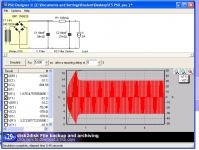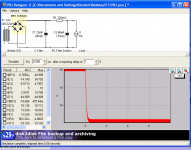ashaw said:Would the following PSU be okay for The balanced F5 posted by Patrik a while ago?
I was thinking 4 Jenson 47000uF caps per rail per channel, could i get away with less?
Look at SM, it can't be much simpler. I have 2x22.000uF followed by 2x 25W R22 and 4x 33.000uF per channel. Across the 22.000 caps additional 1u/250V and the 2k2 5W resistor as well. Hope the simulation is just for one of two required rails per channel.

ashaw said:SM? so like this - per rail?
(note steped load 5 than 10A)
Something like that. 18VAC before the bridge but twice, meaning 18-0-18VAC to get rectified 24VDC per rail, plus and minus 24VDC measured from the center tap. SM is service manual downloadable from passdiy site ...
There's a full schematic drawing of the suggested PSU, but really not critical. Across each 22.000uF goes one 2k2 5W (can go with less power but I had these at hand)
I have a single 500VA transformer (toroid) with four 18VAC secondaries. Go back a few posts and pages and check it out. Very simple, very stable, completely silent... I suggest you get one NTC TH with around 6-10 Ohms for the primary that will act as a soft start and two more to ground the signal's ground. But it's all in the manual...
Here's the direct link to the service manual for F5
http://www.firstwatt.com/downloads/F5-om_sm-080527.pdf
Ok, then, sorry for talking about higher rail voltages. Still, adding the drain resistor across the first pair of caps and being wise about the grounding plus adding the thermistor in the primary remains a valid recommendation. I guess you have the service manual at hand and that you have checked how it was done.
Patrick's balanced Cct uses just 4 amps per channel (2A per side).
Suggest smaller caps in R-C-R-C configuration if using Jensens - not the usual setup but very effective - 1st cap (ripple) = 10,000 (maybe 22) and 2nd cap (power)= 22,000 (maybe those 47s) and R = 0.1R - 0.12R.
Not sure about those 1N5828 diodes on design spec - studs?
Avoid the cheap Jaycar, etc trannie - better to spend some $s.
Suggest smaller caps in R-C-R-C configuration if using Jensens - not the usual setup but very effective - 1st cap (ripple) = 10,000 (maybe 22) and 2nd cap (power)= 22,000 (maybe those 47s) and R = 0.1R - 0.12R.
Not sure about those 1N5828 diodes on design spec - studs?
Avoid the cheap Jaycar, etc trannie - better to spend some $s.
Really, Jest 4A,
so it will do only about 10W?
The diodes are just that, Ones the program has in it's memory bank
so it will do only about 10W?
The diodes are just that, Ones the program has in it's memory bank
Hi All,
This amplifier seems to be very good. Those who have built this ... How does it sound? Which transformer did you use?
Reg
This amplifier seems to be very good. Those who have built this ... How does it sound? Which transformer did you use?
Reg
Wasim said:Hi All,
This amplifier seems to be very good. Those who have built this ... How does it sound? Which transformer did you use?
Reg
Many F5 builders confirm that the F5 sound is great.
You could use any good quality of transformer.
Cheers,
🙂
Babowana said:
Many F5 builders confirm that the F5 sound is great.
You could use any good quality of transformer.
Cheers,
🙂
I confirm its a great amplifier , better with the thermistors .
I have built 4 of them -- they sound great.
I don't know if the thermistors make them sound better, per se, but they are easier to adjust and have slightly lower THD+N% than the non-thermistor version.
I don't know if the thermistors make them sound better, per se, but they are easier to adjust and have slightly lower THD+N% than the non-thermistor version.
One more confirmation to support the capability to play music in an extraordinary manner. Not just a technically well designed piece of hardware, but also a good amp which finally was capable of bringing out the best out of my Philips CD303 (combined with modified NS10 clone and "Shiny" Shunt regulated power supply). It easily drives my ESL panels which made use of almost any other amplifier "Mission Impossible" (if less than 100WRMS) This amp has "only" 25W in Class A and even with a fairly modest dissipation it can cope with anything I tried to listen to. A good choice, one of the best "bangs" for the buck... I have a 500VA toroid with 4x18V secondaries (18VAC)
> Really, Jest 4A,
> so it will do only about 10W?
My balanced version has +/-16V rails and 4A per channel total bias. More the transistors won't take.
Leaving at least 4V Vds for the MOSFETs, I get max swing 24V (as it is balanced output) and 4A. This is set to peak for 6 ohm speakers, giving 48W (rms) assuming sine wave.
For 4 ohm, it will be 32W (current limiting) and for 8 ohm, 36W (voltage limiting).
No idea how you come to 10W.
Regards,
Patrick
> so it will do only about 10W?
My balanced version has +/-16V rails and 4A per channel total bias. More the transistors won't take.
Leaving at least 4V Vds for the MOSFETs, I get max swing 24V (as it is balanced output) and 4A. This is set to peak for 6 ohm speakers, giving 48W (rms) assuming sine wave.
For 4 ohm, it will be 32W (current limiting) and for 8 ohm, 36W (voltage limiting).
No idea how you come to 10W.
Regards,
Patrick
EUVL said:My balanced version has +/-16V rails and 4A per channel total bias. More the transistors won't take.

Avoid the cheap Jaycar, etc trannie - better to spend some $s.
Hi James, I use these transformers for availability price etc. Are they really so bad?
Also, where would you get good transformers in this part of the world that dont hum?
Trannies
Nah Luke,
They're not that bad, just built for minimum cost - just "up-the-size" about 50%. For a better result, go for a simple EI frame with two secondaries for reasonable $s - plenty folks over there build good transformers - ask Beau of "Mosquito" thread.
Torroid? Possibly the best torroids available today is from "Harbuch" in Sydney and quite reasonable cost - big tho'!
Better results with the 240v/50Hz single primary, not the 110v dual primary, 60Hz ones (they're made for exactly that!)
I doubt that line Noise or the DC component is a big problem in NZ, but power filters and DC trap are easy enough.
Also, use U/fast diodes (< 20nS) - makes BIG difference.
Nah Luke,
They're not that bad, just built for minimum cost - just "up-the-size" about 50%. For a better result, go for a simple EI frame with two secondaries for reasonable $s - plenty folks over there build good transformers - ask Beau of "Mosquito" thread.
Torroid? Possibly the best torroids available today is from "Harbuch" in Sydney and quite reasonable cost - big tho'!
Better results with the 240v/50Hz single primary, not the 110v dual primary, 60Hz ones (they're made for exactly that!)
I doubt that line Noise or the DC component is a big problem in NZ, but power filters and DC trap are easy enough.
Also, use U/fast diodes (< 20nS) - makes BIG difference.
Transformers
Luke,
RS Components sell transformers:
http://newzealand.rs-online.com/web...ction.html?method=getProduct&R=2238162#header
This is what I'll be using, I have used 4 Transformers from RS and all this brand, without any problems.
Brett
If you spend $100 they'll give you free delivery so make a decent order first.
Luke,
RS Components sell transformers:
http://newzealand.rs-online.com/web...ction.html?method=getProduct&R=2238162#header
This is what I'll be using, I have used 4 Transformers from RS and all this brand, without any problems.
Brett
If you spend $100 they'll give you free delivery so make a decent order first.
Attachments
Hi All,
Thanks for the reply. Can I use 5k thermistors rather than 4.7k because the 5k thermistors are available here?
Reg
Thanks for the reply. Can I use 5k thermistors rather than 4.7k because the 5k thermistors are available here?
Reg
> 
Why?
Because of +/-16V 2A (I just copied from Grey's Aleph-X) ?
Or because I said the transistor won't take more ?
They are already dissipating 32W continuous. I know they can in theory take more, maybe up to 50W with good thermal management, but reliability drops.
Or you are suggesting 32W is already too much ?
Patrick

Why?
Because of +/-16V 2A (I just copied from Grey's Aleph-X) ?
Or because I said the transistor won't take more ?
They are already dissipating 32W continuous. I know they can in theory take more, maybe up to 50W with good thermal management, but reliability drops.
Or you are suggesting 32W is already too much ?
Patrick
- Home
- Amplifiers
- Pass Labs
- F5 power amplifier

